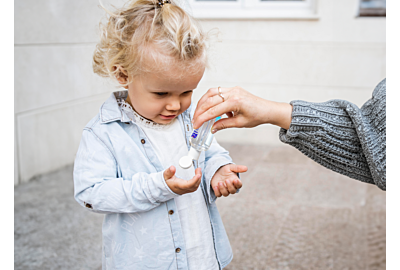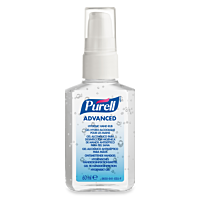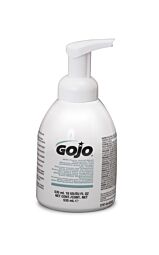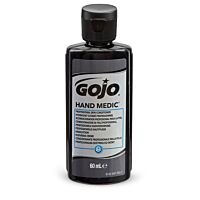Author: By Dawn Yeomans, Ph.D. - Research Principal, GOJO Industries
Adapted by Romina Peralta
Understanding the Winter-Hand Blues
Do your kids suffer from dry, damaged, irritated hands as the weather grows colder? If so, they’re not alone. Winter weather is not fun for skin; cold weather, low humidity, and indoor heating create dry air, which steals moisture away from the skin every second of every day. Scientific studies have shown that the top layers of skin, called the stratum corneum, hold 25% less water in low humidity conditions. 1
That’s bad enough, but unfortunately, weather is only part of the problem. Repeated handwashing to keep winter germs at bay also wreaks havoc on already fragile hands. There are reasons why children, especially young children, may be at higher risk of developing dry, irritated, cracked hands. This is because, compared to adults, children:
- May wash their hands more frequently due to more dirt and soils on their hands and in line with heightened germ-prevention approaches in childcare and school settings.
- Typically spend more time outdoors.
- Commonly suffer from eczema, with as many as 1 in 5 children in the UK.2
- They are less likely to moisturise their hands regularly.
- Have thinner, more delicate skin that is more prone to lose moisture quickly, particularly if they are less than four years of age.3
Without immediate and ongoing care, children’s dry skin can worsen. Continued exposure to harsh winter wind and indoor heat – combined with frequent handwashing with harsh cleansers – makes the problem spiral out of control. The result is painful, cracked skin, a condition where germs are more likely to enter the body. Unfortunately, many children avoid washing painful, cracked hands, leaving them even more vulnerable to germs that are commonly found in the winter months. And of course, if kids are not washing their hands, it’s also possible to spread germs to other objects and individuals inside and outside the home, perpetuating the germ cycle.
Tips to Combat Winter-Hand Blues
There’s not much we can do about the weather and practicing frequent hand hygiene is certainly a must in today’s world. Luckily there are some ways to avoid the “winter-hand blues.” Here are a few tips to help protect vulnerable little hands:
- Choose a gentle soap. Many soaps contain harsh detergents such as sodium dodecyl (lauryl) sulphate – which can strip natural oils from the skin, making them look and feel dry and irritated. Instead, choose a mild hand soap containing moisturising and soothing ingredients like glycerine, ceramides, natural oils, vitamin E, or aloe vera.
- Use lukewarm water. Hot water may strip skin’s natural skin oils more quickly and further dry and irritate hands. When washing their hands, kids should use warm water.
- Apply moisturisers after washing. The best time to moisturise is before hands start showing signs of dryness, flaking/itching, redness, or cracking. If possible, throughout the day, apply a light moisturiser to lock in moisture after washing hands. Consider adding a travel-size bottle of lotion to your child’s backpack. Night-time is also an excellent opportunity to replenish skin moisture, using a heavier cream lotion or an ointment containing mineral oil or petrolatum. These moisturisers will soak in and hydrate skin overnight.
- Wear gloves. It’s important to keep little hands warm and protected from the harsh elements, so make sure kids wear gloves or mittens when outside. The cold air and blustery winds can quickly dry out their skin. Keeping their hands covered helps limit moisture evaporation and protects their skin from the cold, dry air.
- Pat dry – don’t rub. In the winter, it’s important to treat skin gently when washing and drying hands. Drying is important for germ removal but avoid rubbing skin vigorously, as friction between the towel and skin may cause damage. Instead, gently pat or dab hands dry.
- Avoid unnecessary allergens and irritants. If your child suffers from eczema, dermatitis, or psoriasis, you may want to avoid allergens and irritants that may worsen the condition, which frequently flares in the winter months. Fragrance-free, in particular, may be a good option.
- Consider using hand sanitiser instead of soap when hands aren’t visibly soiled. Soap and water rinse away soils but also can strip the natural, protective oils in skin, causing it to dry out. Well-formulated hand sanitisers contain moisturising ingredients like glycerine or skin softeners – called emollients – to keep moisture in.
- Share this information with your child in an age-appropriate way to help create lasting habits to keep skin looking and feeling good throughout the year.
Avoid the “winter hand blues” with GOJO® and PURELL® brand soaps and hand sanitisers, which are formulated to be mild and gentle to skin.
1. Engebretsen KA, Johansen JD, Kezic S, Linneberg A, Thyssen JP. The effect of environmental humidity and temperature on skin barrier function and dermatitis. J Eur Acad Dermatol Venereol. 2016 Feb;30(2):223-49.
2. National Eczema Society. (n.d.). Information and advice. Retrieved December 6, 2023, from https://eczema.org/information-and-advice/
3. Walters R, M, Khanna P, Chu M, Mack M, C: Developmental Changes in Skin Barrier and Structure during the First 5 Years of Life. Skin Pharmacol Physiol 2016;29:111-118.
















